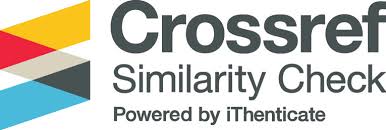Lembaga Keuangan Mikro Adat Sebagai Penggerak Perekonomian Desa Lambing
(Kajian Analisis Kinerja Berbasis Balance Scorcard)
Abstract
This study aims to analyze the performance of Lambing Badung Regency customary microfinance institutions which are assessed from four perspectives, namely: (1) financial perspective, (2) customer perspective, (3) internal business process perspective, and (4) learning and growth perspective. This study is a type of quantitative descriptive study that explains the performance of customary microfinance institutions in 2017 - 2019. Data are collected using questionnaires, documentation, and interviews which are then analyzed using the balanced scorecard approach. This study found the fact that the performance of Lambing indigenous microfinance institutions based on four perspectives: (1) the overall finance is in the healthy category, (2) the overall customer is in a good category, (3) the internal business process is classified as efficient, and (4) learning and growth as a whole are in a good category. By having a good performance, this institution is expected to be more developed and of course, with the development of customary microfinance institutions, the economy in the area will also be increasingly stretched which can become a pillar driving the economy so that there is an acceleration of the welfare of rural communities.
References
Audenaert, M., Decramer, A., George, B., Verschuere, B., & Van Waeyenberg, T. (2019). When employee performance management affects individual innovation in public organizations: The role of consistency and LMX. The International Journal of Human Resource Management, 30(5), 815–834.
Bala, R. P. (2017). Analisis Penilaian Terhadap Kesehatan BPR dengan Menggunakan Faktor CAMEL Berdasarkan Peraturan Bank Indonesia. Riset Manajemen Dan Akuntansi, 8(1).
Baskara, I. G. K. (2013). Lembaga Keuangan Mikro di Indonesia. Buletin Studi Ekonomi, 44233.
Bostan, I., & Grosu, V. (2011). Contribution of balance scorecard model in efficiency of managerial control. Romanian Journal of Economic Forecasting, 14(3), 178–199.
Gawankar, S., Kamble, S. S., & Raut, R. (2015). Performance Measurement using Balance Score Card and its Applications: A Review. Journal of Supply Chain Management Systems, 4(3), 6–21.
Hu, B., Leopold-Wildburger, U., & Strohhecker, J. (2017). Strategy map concepts in a balanced scorecard cockpit improve performance. European Journal of Operational Research, 258(2), 664–676.
Ishak, D., Maolani, D. Y., & Engkus, E. (2017). Konsep Kinerja Dalam Studi Organisasi Publik. JISPO Jurnal Ilmu Sosial Dan Ilmu Politik, 7(2), 101–120.
Kipesha, E. F. (2013). Performance of microfinance institutions in Tanzania: integrating financial and non financial metrics.
Krisna, A. (2018a). Metode Mudah Memahami Pengantar Ekonomi Makro (P. S. Wibawa, Ed.; 1st ed.). CV Sastra Darmastuti.
Krisna, A. (2018b). UMKM Jangkar Stabilitas Perekonomian Bali. In G. Sindhu (Ed.), Bali Dalam Narasi (1st ed., pp. 187–212). PT. Japa Widya Duta.
Marwansyah, S. (2016). Analisis Perbandingan Rasio Rentabilitas Roa, Npm, Roe Pada Bank Bumn Periode 2007-2015. Konferensi Nasional Ilmu Pengetahuan Dan Teknologi, 2(1), 1 – MN.8. http://konferensi.nusamandiri.ac.id/prosiding/index.php/knit/article/view/99
Putra, Y. P., & Laely, N. (2015). Analisis Laporan Keuangan Berdasarkan Rasio Likuiditas, Solvabilitas, dan Rentabilitas untuk menilai kinerja keuangan pada koperasi Manunggal Universitas Kadiri. Jurnal Kompilasi Ilmu Ekonomi (KOMPILEK), 7(1), 89–98.
Qiguang, Z., & Wei, G. (2015). Research on the performance evaluation of small and micro businesses microfinance of commercial bank based on balanced Scorecard and principal components analysis. AASRI International Conference on Industrial Electronics and Applications (IEA 2015).
Sanjaya, I. K. P. W., & Dana, P. E. D. A. (2018). Analisis Tingkat Kesehatan Lembaga Perkreditan Desa (LPD) Ditinjau Dengan Metode Capital, Assets, Management, Earning dan Liquidity (Studi Kasus Pada LPD Di Kecamatan Kuta). KRISNA: Kumpulan Riset Akuntansi, 9(2), 71–76.
Sanjaya, P. K. A. (2019). Analisis Beberapa Faktor Yang Berpengaruh Terhadap Harga Saham Firm Farmasi Yang Terdaftar Di Bursa Efek Indonesia: Analisis Fem Data Panel. Prosiding, 275–292.
Sanjaya, P. K. A., Widnyana, I. N. S., & Nuratama, I. P. (2019). Pemberdayaan Prajuru Lembaga Keuangan Mikro Adat Melalui Penerapan Teknologi Informasi Di Desa Kesiut Kecamatan Kerambitan Kabupaten Tabanan. JURNAL SEWAKA BHAKTI, 3(1), 25–39.
Saputra, K. A. K., & Kurniawan, P. S. (2017). Konsep Good Corporate Governance Dan Fungsi Badan Pengawas Sebagai Internal Auditor LPD Di Bali. Simposium Nasional Akuntansi XX, Universitas Jember.
Seibel, H. D. (2013). Culture and governance in microfinance: Desa pakraman and lembaga perkreditan desa in Bali. In Microfinance in Developing Countries (pp. 107–126). Springer.
Suartana, I. W., & Ariyanto, D. (2012). Analisis Kinerja Internal, Balance Scorecard Dan Pengembangan Keuangan Mikro Berkelanjutan (Studi Pada Lembaga Perkreditan Desa Di Provinsi Bali). Jurnal Akuntansi Dan Auditing, 9(1), 56–69.
Sugianingrat, I. A. W., Sanjaya, P. K. A., & Nuratama, P. (2019). Pemberdayaan Pengelola Lembaga Ekonomi Komunitas Adat Melalui Penguasaan Teknologi Informasi Di Desa Jungut Kabupaten Klungkung, Bali. JURNAL SEWAKA BHAKTI, 2(1), 21–34.
Wijaya, A. (2019). Metode Pnelitian Menggunakan Smart PLS 03 (1st ed.). Innosain.
Yandani, N. M. M., & Suryanata, I. G. N. P. (2019). Pengaruh Penerapan Prinsip-Prinsip Good Corporate Governance Dan Budaya Tri Hita Karana Terhadap Kinerja Manajerial Lembaga Perkreditan Desa (Lpd) Pakraman Padangsambian. Jurnal Ilmiah Akuntansi Dan Bisnis, 4(1), 24–37.
Reproduction Policy
Every author submitting articles to Widya Manajemen must make a statement that the manuscript is free from plagiarism and is not being considered and published in other journals.
Articles that have been published are copyrighted by the Program Studi Manajemen FEBP UNHI. For educational purposes, the contents of the article may be duplicated or reproduced as long as the source of the article is mentioned. Written requests must be submitted to the editor to obtain permission to republish the contents of the article for purposes other than educational purposes.
-----------------------------------------------------------------------------------------------------
Kebijakan Reproduksi
Setiap penulis yang menyerahkan artikel ke Widya Manajemen harus membuat surat pernyataan bahwa naskahnya bebas dari plagiarisme dan tidak sedang dipertimbangkan dan dimuat dalam jurnal lain.
Artikel yang telah dipublikasi menjadi hak cipta Program Studi Manajemen FEBP UNHI. Untuk tujuan edukatif, isi dari artikel dapat digandakan atau direpublikasi selama menyebutkan sumber dari artikel tersebut. Permintaan tertulis harus diajukan kepada editor untuk memperoleh ijin merepublikasi isi dari artikel untuk tujuan lainnya selain tujuan edukatif.






.jpg)









